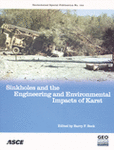Hydrogeologic Investigation of Leakage through Sinkholes in the Bed of Lake Seminole to Springs Located Downstream from Jim Woodruff Dam
Publication: Sinkholes and the Engineering and Environmental Impacts of Karst
Abstract
Jim Woodruff Dam was constructed across the Apalachicola River on the Florida-Georgia border to create Lake Seminole. Polk Lake Spring is located about 244 m (800 ft) downstream, and a large boil, created by water rising from a hole in the river bed, is located in the Apalachicola River about 549 m (1,800 ft) downstream. This research was initiated by the Mobile District U.S. Army Corps of Engineers to determine if water from the spring and/or boil is leakage from the reservoir, groundwater, or both. Five potential leakage sites were identified on the bed of Lake Seminole. The most distant hole identified by a lake bed survey was approximately 434 m (1,425 ft) upstream from the dam. A dye tracer investigation was conducted to determine if leakage from these sites was contributing to the discharge at the spring and/or boil located downstream from the dam. Three fluorescent dyes were used for the tracer tests. The investigation indicates that lake water sinking into holes in the lakebed is flowing through old solution conduits in the limestone bedrock that existed previous to dam construction. All the leakage confirmed by dye tracing is resurging at the boil located in the river downstream from the dam. However, some of the leakage first resurges at Polk Lake Spring and then sinks at Polk Lake Sink to finally resurge at the boil. The dam was built upon the lower Tampa Limestone (Chattahoochee), a semi-confining unit for the Upper Floridan Aquifer. The geologic dip in the vicinity is downstream perpendicular to the dam. The Suwannee Limestone, the uppermost geologic unit of the Upper Floridan Aquifer, outcrops under Lake Seminole but dips below the Tampa semiconfining unit in the vicinity of the dam. The actual route taken by the sinking lake water to the boil is unknown. However, two hypotheses are presented. First hypothesis: leakage is occurring through reactivated sinkholes in the lake where the Tampa semiconfining layer is thin. This leakage is then flowing through the Suwannee Limestone (Upper Floridan Aquifer) down dip to resurge as an artesian spring at the boil located about 549 m (1,800 ft) downstream from the dam. Second hypothesis: leakage is flowing through the Tampa Limestone directly to Polk Lake Spring and the boil.
Get full access to this chapter
View all available purchase options and get full access to this chapter.
Information & Authors
Information
Published In
Copyright
© 2005 American Society of Civil Engineers.
History
Published online: Apr 26, 2012
Authors
Metrics & Citations
Metrics
Citations
Download citation
If you have the appropriate software installed, you can download article citation data to the citation manager of your choice. Simply select your manager software from the list below and click Download.
